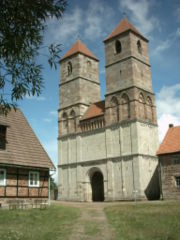
Vessra Abbey
Encyclopedia

Premonstratensian
The Order of Canons Regular of Prémontré, also known as the Premonstratensians, the Norbertines, or in Britain and Ireland as the White Canons , are a Catholic religious order of canons regular founded at Prémontré near Laon in 1120 by Saint Norbert, who later became Archbishop of Magdeburg...
monastery in the village also named Kloster Veßra
Kloster Veßra
Kloster Veßra is a municipality in the district of Hildburghausen in Thuringia, Germany.Vessra Abbey was founded and supported by the Henneberg family and abandoned after the Reformation. The church was used as a parish church until 1939 when it burned...
in the district of Hildburghausen
Hildburghausen (district)
Hildburghausen is a district in Thuringia, Germany. It is bounded by the district of Schmalkalden-Meiningen, the city of Suhl, the districts of Ilm-Kreis, Saalfeld-Rudolstadt and Sonneberg, and the state of Bavaria...
, Thuringia
Thuringia
The Free State of Thuringia is a state of Germany, located in the central part of the country.It has an area of and 2.29 million inhabitants, making it the sixth smallest by area and the fifth smallest by population of Germany's sixteen states....
, Germany
Germany
Germany , officially the Federal Republic of Germany , is a federal parliamentary republic in Europe. The country consists of 16 states while the capital and largest city is Berlin. Germany covers an area of 357,021 km2 and has a largely temperate seasonal climate...
.
The monastery was founded in the 1130s by Gotebold II, Count of Henneberg
Henneberg
Henneberg may refer to:*the House of Henneberg, German nobility*County of Henneberg, a mediæval state in the Holy Roman Empire*Henneberg, Thuringia, a municipality in Thuringia, Germany*Mary Jane Henneberg, b. 1973, TV reporter...
, and his wife Liutgard on a site near the confluence of the Schleuse and the Werra
Werra
The Werra is a river in central Germany, the right-source river of the Weser. The Werra has its source near Eisfeld in southern Thuringia. After 293 km the Werra joins the river Fulda in the town of Hann. Münden, forming the Weser....
. The church was dedicated in 1138; the foundation received papal confirmation three years later.
For the whole of its existence of more than four hundred years the abbey was a family monastery of the Hennebergs. It also had a close association with the von Bibra family, particularly in the 15th century. During the Reformation
Protestant Reformation
The Protestant Reformation was a 16th-century split within Western Christianity initiated by Martin Luther, John Calvin and other early Protestants. The efforts of the self-described "reformers", who objected to the doctrines, rituals and ecclesiastical structure of the Roman Catholic Church, led...
in 1543, the monastery was turned into an estate.
The former monastery served another four hundred years as an agricultural estate, mostly in private hands, but after World War II
World War II
World War II, or the Second World War , was a global conflict lasting from 1939 to 1945, involving most of the world's nations—including all of the great powers—eventually forming two opposing military alliances: the Allies and the Axis...
as a possession of the East German
German Democratic Republic
The German Democratic Republic , informally called East Germany by West Germany and other countries, was a socialist state established in 1949 in the Soviet zone of occupied Germany, including East Berlin of the Allied-occupied capital city...
state, and from 1953 as the site of a collective farm (Landwirtschaftliche Produktionsgenossenschaft, or LPG).
In 1975 the site was taken over by the Museum of the History of Agriculture of the DDR (Agrarhistorisches Museum der DDR). Since 1990 the site has been the home of the Hennebergische Museum, an open-air museum specialising in the display of re-located local buildings.
The abbey church, dedicated to Saint Mary, was converted to the parish church, with much of the space used for storage. Most of the church structure was heavily damaged in a 1939 fire. One chapel continues to be used. The ruins are nevertheless substantial and after stabilisation it remains the most significant Romanesque
Romanesque architecture
Romanesque architecture is an architectural style of Medieval Europe characterised by semi-circular arches. There is no consensus for the beginning date of the Romanesque architecture, with proposals ranging from the 6th to the 10th century. It developed in the 12th century into the Gothic style,...
building in the region. Of the monastic buildings themselves there remain the gate chapel and the accommodation block, with the ruins of the cloister.

